Organizing in the midst of Extinction
Author(s)
Extinction Rebellion Utrecht, Selçuk Balamir
Extinction Rebellion (XR) entered the spotlight in late 2018 with a call for mass disruptions, followed by a first wave of actions which saw thousands come together to block major bridges in London.

Extinction Rebellion (XR) entered the spotlight in late 2018 with a call for mass disruptions, followed by a first wave of actions which saw thousands come together to block major bridges in London. Borrowing from the history of civil disobedience and breaking some new ground in its tactics and aesthetics, XR attracted a following and level of media attention previously unattainable for grassroots environmental organizing. This was the same autumn when Greta Thunberg sparked the school strikes for climate that would galvanize millions of students to take to the streets. After decades-long frontline resistance against extractivism, spearheaded by indigenous struggles across the world, the timing was right for a global climate justice movement to take leaps.
If tactics, aesthetics, and public discourses constitute only the tip of the proverbial iceberg, organizational characteristics that are hidden from view can reveal much more about the merits of a grassroots group. A few such features set XR apart from other environmental campaigns. Ten principles constitute the “DNA” of the organization, and the name can be adopted freely by anyone who follows these core principles: to have a shared vision of change; to focus on what is necessary and mobilise people accordingly; to create a regenerative culture that is healthy, resilient, and adaptable; to not only challenge toxic systems but one another as well; to focus on reflection and learning in tandem with action; to be welcoming to everyone; to avoid hierarchies and mitigate power; to avoid blaming and shaming one another; to pursue non-violent strategies; to base their organisation on autonomy and decentralisation. Its theory of change relies on meeting three demands addressed to national governments: to tell the truth by declaring a climate and ecological emergency, to act immediately to halt biodiversity loss and reduce greenhouse gas emmissions to net zero by 2025, and to establish a citizens’ assembly based on a sortition model (a randomized but demographically representative selection of representatives for deliberation and decision making). The internal structure is conceived as a “self-organizing system” intended to align autonomous groups as part of a broader network of organizing. These characteristics make XR a living laboratory and a case study which fits the current focus of BAK’s digital forum Prospections: How to Assemble Now.
The Netherlands branch, XR-NL, was founded in 2019 as an independent group inspired by the organization that originated in the United Kingdom. Along with its several early surprise actions, a blockade in front of Amsterdam’s Rijksmuseum was one of the highlights of the International Rebellion week that took place in October 2019. In 2020, Covid-19 forced XR-NL to cancel their spring actions, but others were carried out during a September Rebellion. Alongside the coordination circles that steer the national campaign, XR-NL currently counts 32 local groups and a structure increasing in complexity. In order to accommodate growing pains and adapt the organization to the Dutch context, an internal citizens’ assembly was organized in August 2020, facilitated by the national organization, which brought together 30 participants and was hosted by BAK, basis voor actuele kunst, Utrecht.
Inquiring further on the structure and organizing process of XR-NL, the interviews below were conducted with three “rebels” in the weeks following this assembly. The conversation has been shortened and revised for legibility.
Selçuk Balamir: Would you please introduce yourselves, and tell how you got involved with XR?
Eva Dassen: I’ve been involved in XR for one year. At first, it was low key, and at some point, it “escalated” [laughs]. That was mainly because my passions really came together with XR: I’m very concerned about the climate and ecological crises, but I also realized how much I cared about community building, deliberate processes, and dialogue within the movement. I was helping out with XR’s peoples’ assemblies and I felt that I’d love to dive deeper into it. I paused part of my studies, taking only two of eight courses in political philosophy, and the rest of my time was spent on XR, focusing especially on processes and self-organizing systems.
Floris Bernard: I’m a programmer and web developer. I’ve been active in XR since last October. Until that point, I had always wanted to do something with or about climate, but I couldn’t find an organization or movement where I really felt at home. I was introduced to XR right before their October Rebellion. I took a week off work and it ended up being one of the most amazing experiences of my life. About a month later, I quit my job to work full time for XR, until I ran out of savings after a couple of months. I’ve since returned to work as a developer for The Correspondent. In XR, I was also involved with some circles that were coordinating the movement, and I was really interested in the difference between that process and the citizens’ assembly.
Moritz Harzenetter: I am originally from Germany. I came to the Netherlands to study Sustainable Development at Utrecht University. I was heading toward sustainability consultancy, which is what a lot of graduates in my program do, but I felt like that was not enough. Although it is important that there are consultants to advise companies on how to measure their impact on the climate and reduce it, we’re heading straight toward a climate catastrophe, and I don’t think that sustainability consultancy will save us. It was a talk from XR that sparked my interest in the organization. The talk, which was based on the latest climate science, demonstrated how we are literally doomed, and that spoke to my emotionally fragile state of mind. I had never been part of an activist or political group, but I realized the need for civil disobedience, as XR had been doing.
SB: I’d like to hear about your impressions with the internal organizing structure of XR. What are the frustrations and imperfections that you or others have experienced?
MH: It wasn’t necessarily frustrating for me, but there can be a lack of clarity over decision making, mandates, and responsibilities. An example of this is that during the Covid-19 lockdown, the local group in Amsterdam sent letters out to all politicians in the House of Representatives. This didn’t amuse our national political circle, which liaises with politicians on national level. The letters were regarded as being misaligned with the strategy the national working group had been following at that time. So that resulted in a clash about mandates: when should you ask for advice, and how do you integrate all this into what you’re planning? I think this showed our lack of knowledge in decision-making processes, and raised many interesting questions: Who gets to decide what? When can people make autonomous decisions and when is seeking advice recommended? How do local and national groups relate to each other?
FB: I’ve been active in the national coordination circle handling tech responsibilities. But I’ve also been involved at a more local level with autonomous groups such as the Red Rebels art group or a community kitchen. I noticed quite a big difference between how the national coordination circles and other autonomous groups functioned. I think it may relate to a lot of reasons, for example, people in the coordination group may have more time or financial means to set this time apart. But it also takes a certain kind of personality to read and write these kinds of reports. For some people this is immediately a no go; they just want to do stuff. It’s really important to make those voices heard as well. If you don’t, you run the risk of these specific organizational types of personalities reinforcing themselves. The more you see one kind of person in these coordination circles, the more it’s going to nudge different kinds of people away. Ultimately, we all feel the urgency of the climate crisis, and on top of that is the urgency of organizing big events and gatherings. The pressure increases exponentially, and because of that, people get burned out. We need to break that cycle.
ED: I think that process of cyclical burnout is also a matter of communication flow. Many people would like to help out more and have a lot to contribute, but it’s not always clear how they can do so. By making clear what you can do and in what way you can contribute to the organization, you ensure that all kinds of people can contribute in many different ways. We don’t only need people on the streets and people who speak very well to the press; we also need community builders, people who are there to listen to others. This is not only about being more inclusive and producing new organizational systems, but it also about how we can become more effective. We don’t want a system where people constantly burn out, where information is lost, where people become drained and frustrated with the system, and so on.
SB: What made you launch this process and hold an internal citizens’ assembly? Were there many others who shared your motivation to tackle these issues?
ED: At one point, I realized that if we wanted to address how we are making decisions and organizing, we could not only do this within the coordination circle, as it only included very few people. How could we get all different kinds of voices involved in this process that influences the whole movement? If we gathered everybody together, we would have too many people to make an effective decision. So, then I thought: we have this meaningful idea to organize national citizens’ assemblies that are based on representation and deliberative conversations. Why not adapt it to a smaller scale within our own organization? We needed to make sure that people who were not as active in XR were still involved in decision making about how they would like to organize. So we made an internal citizen’s assembly.
MH: I remember reaching out to a professional facilitator who introduced me to the concept of “navigating by tensions.” It is the idea of using tensions to form new concepts that can solve certain difficulties. We attempted to use this process in a coordination circle meeting. I think the tension that we defined was: “How can we make decisions that are both inclusive and effective?” This is still a big tension that XR faces.
SB: What kind of groundwork was needed for this assembly? How did you incorporate all these voices, and how did you establish legitimacy through representation?
ED: We had our own observations from the national, heavy involvement level, but I was aware they would be limited. So we sent out a very big survey through our newsletter as part of a bigger process of determining the movement strategy for the coming year. It consisted of all kinds of questions about the strategy itself, on an action timeline, and on how to make our organizational structure more inclusive and effective. Because we were planning to assemble this internal citizens’ assembly, we needed to know the demographics of our members, such as age, gender, educational background, and so on. We received 500 replies which we analyzed in many different ways. We organized a general meeting to discuss our strategy, which was open to everyone, and for questions of organizational structure, we held this internal citizens’ assembly. We based the agenda for the assembly on the findings of the survey. But I would actually not necessarily advise that, because people coming into the room have their own experiences and they don’t like an agenda being imposed on them. I’d suggest that they can instead make the agenda as part of the assembly itself, so that they feel ownership of the process.
MH: I learned that the design of the assembly is very crucial for the legitimacy of the process. The tension I experienced was that we wanted to redesign, or deliberate on, what kind of structure we wanted to operate under, but had a sample of participants that was not fully representative of the composition of our movement. It lacked some representatives active in national circles. I really think that we need to take the organization of these events seriously, because we are in it for the long run.
FB: I noticed after hearing both of you speak about how the day went, that my feeling leaving the citizens’ assembly was quite different from both of yours’. You possibly didn’t have the time or the headspace to be wholly part of the conversation, especially in the breakout sessions. To me it was a magical experience. I went in there with notes and presumptions: I want this and this. But to my surprise, many other people had come to almost the exact same conclusions as me, and were able to word them better than I could have done myself. So, the prevailing feeling I have from the day is of everyone being so in sync with their conversations. Sometimes there was some friction about the planning and structure, but that wasn’t my main takeaway from the day.
SB: How was the gap bridged between those who were highly committed, highly informed facilitators providing the analysis and proposals, and the bulk of participants who were either inactive or less opinionated about the structure?
FB: It varied a lot. Some of the participants were indeed less opinionated and less active, and some were the opposite. I think that in such a fast-moving organization you start to replicate the kind of systems you see in society, like productivism. But a lot of people who joined XR have a different mindset, and we need to hear especially from these people. These people are often less active because they have a difficult time finding their spot in a very fast-moving organization.
ED: Maybe I would like to add to that. One of the participants put it really well: “There is an urgency. I feel this every day. We need to act now.” But we also don’t want to rush things when developing a new system. So, it’s a big tension in the movement, and it’s very difficult for an activist group to hold together. But I do think it’s possible. I do feel that through the internal citizens’ assembly I can envision these things in parallel: that I want to participate in radical action, and that I want to have time for community building. I want to have time for reflecting, and I want to have time for exploring new systems. The problem is that these new systems are often easier to imagine as abstract ideas; it is much more difficult to put them into practice.
SB: What hope and confidence does this experience give you for implementing assemblies on a larger scale and with a greater variety of participants?
ED: Citizens’ assemblies are great for moving away from polarization toward a “coming together.” When experts talk about climate policy, they distinguish mitigation and adaptation. It is such a complex problem to mitigate emissions and reduce the heavy consequences of our treatment of the planet. But adaptation is equally hard, because we will have to deal with increasingly difficult situations. How do we deal with food shortages, for example? Citizens’ assemblies are a way of reaching both mitigation, by proposing measures, and adaptation, by learning how to make decisions together. With this escalating crisis, it is only going to become more and more challenging to live with and to reach decisions together. We need to learn how to collaborate, how to trust each other, how to come together. Citizens’ assemblies are a new way of establishing a culture around that. It’s also really a paradigm shift in my opinion to bring all the voices together to contribute to the overall outcome. It’s not a debate that you win or lose; it’s about finding solutions together.
FB: This paradigm shift is a really valuable thing in itself. We’ve become so used to the way our democracy and our politics function. I hope we can show people that they don’t necessarily have to accept all the systems that they live under. There are new ways to envision things together, and we can always experiment with new ways of relating to each other.
ED: Ultimately, it’s about empowerment. It’s moving on from the feeling that change is impossible, to the process of making it happen.
Related

“Schooling Assembly” by Nora N. Khan traverses a year of pandemic teaching, in which faculty and students have witnessed widening cracks in the university system and its human opportunity cost calculations, and have faced new challenges in asserting creative and collective autonomies.

Extinction Rebellion (XR) entered the spotlight in late 2018 with a call for mass disruptions, followed by a first wave of actions which saw thousands come together to block major bridges in London.
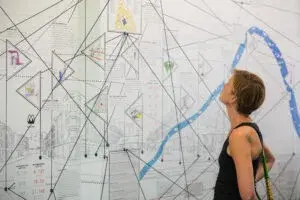
Dit diagram van kunstenaar Jeanne van Heeswijk vertelt het verhaal van Freehouse Radicalizing the Local (2008–2019), een project gericht op de strijd voor het recht op een goed leven in de Afrikaanderwijk in Rotterdam.
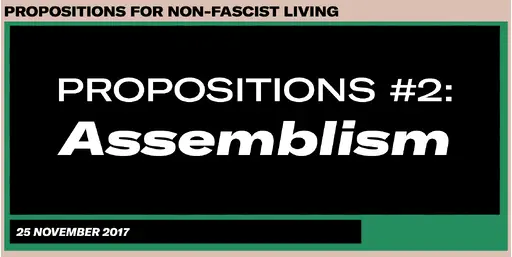
The event Third Assembly: After the Assembly took place as part of the daylong program Propositions #2: Assemblism, convened by BAK and artist Jonas Staal on 27 November 2017.
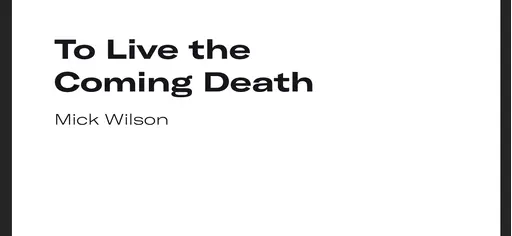
Uit: Propositions for Non-Fascist Living: Tentative and Urgent, Maria Hlavajova and Wietske Maas, eds. (Utrecht: BAK, basis voor actuele kunst en Cambridge, MA: MIT Press, 2019), pp. 165-179
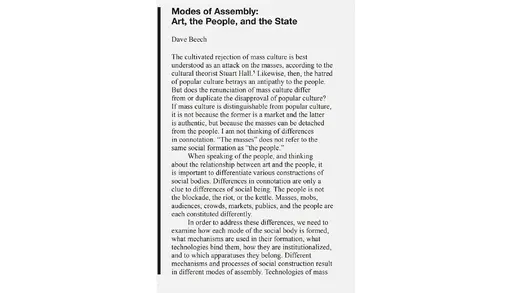
Uit: FORMER WEST: Art and the Contemporary After 1989, Maria Hlavajova en Simon Sheikh, eds. (Utrecht: BAK, basis voor actuele kunst and Cambridge, MA: MIT Press, 2016), pp. 559-569
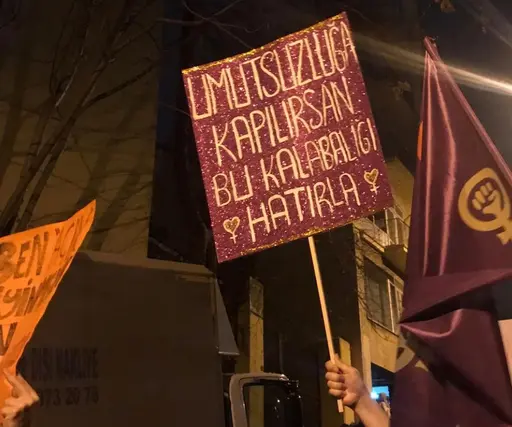
"We were in the streets for the Feminist Night March on 8 March, exactly three days before the first Covid-19 case was officially declared in Turkey..." Read the translation of an essay originally published in Turkish on 1+1 Forum, 30.04.2020.